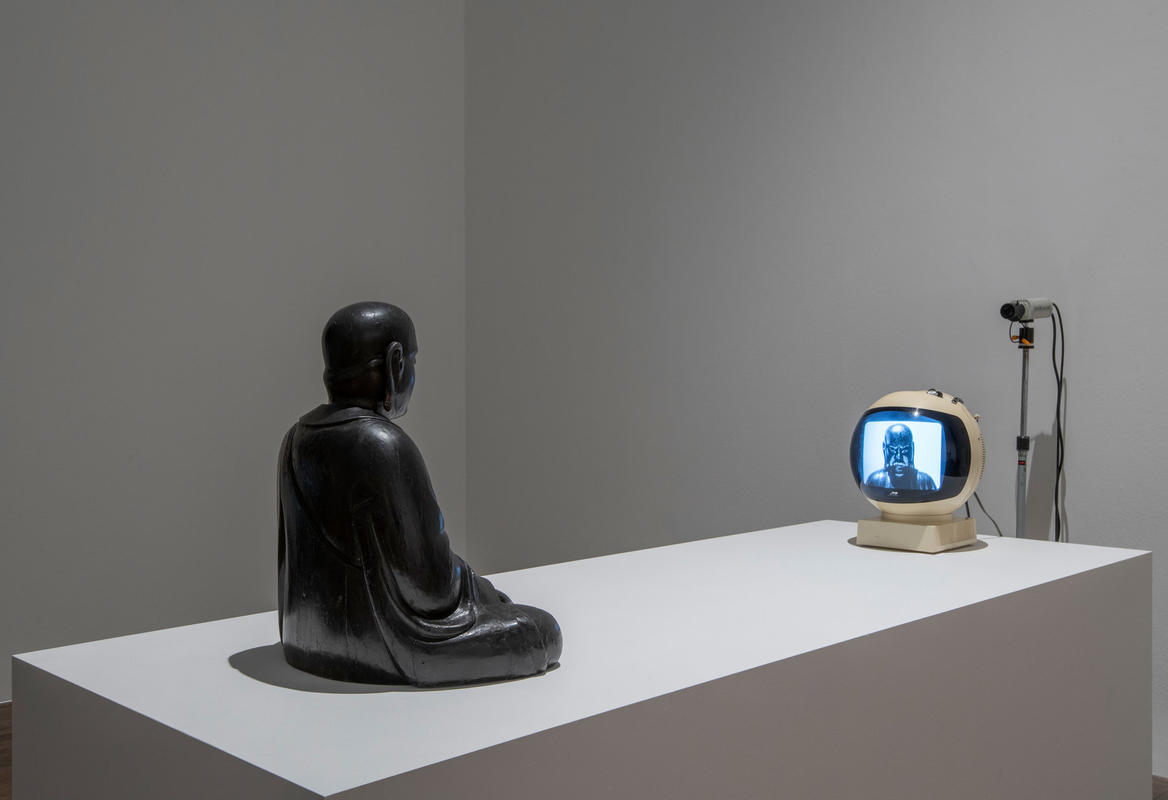More about TV Buddha

Contributor
TV Buddha by Nam June Paik is the type of art that stops you in your tracks when you first see it, and leaves a lingering impression long after you’re gone.
Created in 1974, TV Buddha integrates a television camera, a futuristic looking circular monitor, and a wooden statue of Buddha. The statue, which is life sized, is from the 18th century. Instantly, whether you have the language to describe it or not, you inherently understand that the two major pieces in this work of art are from two different times. Even if you don’t know that the Buddha is from the 18th century, it represents a different type of world, more ancient than the television. Not only is it a contemplation of old vs. new, but it’s also a study on eastern and western practices. What really makes TV Buddha so special is how Paik manages to have the two worlds meet in the middle in such a profound way.
Depending on what angle you first see TV Buddha, it might look like that Buddha is just watching television. That in itself is a pretty deep thing to contemplate. It says a lot about meditation, religion, worship, and how that evolves in the age of ever-changing technology. But you soon realize that not only is the Buddha staring into the television, but he’s staring back at himself on the screen because of the camera present.
That’s when things begin to feel almost a bit sinister, or at the very least, unsettling. It doesn’t feel right. Not that old and new, east and west can’t coexist, but the ever tranquil Buddha is being encroached upon and exploited by the television. And the Buddha is forced to watch, not able to do anything to make it stop.
That outlook is a little bleak, even if there are elements of truth that can be applied to real life. But I choose to prescribe to a more positive outlook. The television, representing the west, and the new, may be exploiting the Buddha, but the Buddha still meditates. He may be aware that things can’t change, but he’s steadfast in his conviction to stay true to who he is and what he does.
Alternatively, it’s easy to look at this piece in a broader sense as well. Strip away the ideas surrounding east, west, old, and new, and you’ve still got a very strong symbol: Meditation. The Buddha represents an inward form of meditation, where we find peace within ourselves. And the television represents a form of meditation where it’s easy to escape your problems, finding peace in the moments that we can forget. Where it gets interesting is in the middle, where the Buddha sees himself on the television. This could point to something out of George Orwell’s 1984, where the idea of technology evolving means less privacy, and ultimately less individuality. But it could also be saying something about how seeing yourself in these spaces of advancement is something that can help you achieve some peace within yourself.
Nam June Paik also had a lot of ideas when it came the themes covered here. He revisited similar ideas in Stone Buddha/Burnt TV (1982), which includes a Buddha looking over a burnt television, TV Rodin (1982), where a mini version of Auguste Rodin's The Thinker is placed on top of a Sony Watchman, and TV Buddha (1982) which includes a Buddha studying a screen covered in dirt.
Sources
- Curiel, Jonathan. “Nam June Paik Transcends the Screen. SF Weekly. May 19, 2021. https://www.sfweekly.com/culture/nam-june-paik-transcends-the-screen/
- Hyperallergic. “SFMOMA Presents US Exclusive Retrospective of Visionary Artist Nam June Paik” May 10, 2021. https://hyperallergic.com/644520/sfmoma-presents-us-exclusive-retrospec…
- The Art Story. “Nam June Paik Artworks. Accessed July 19, 2021”. https://www.theartstory.org/artist/paik-nam-june/artworks/
Featured Content
Here is what Wikipedia says about TV Buddha

TV Buddha is a video sculpture by Nam June Paik first produced in 1974, but exists in multiple versions. In the work, a Buddha statue watches an image of itself on a TV screen. The screen's image is produced by a live video camera trained on the Buddha statue.
The work was initially produced to fill a gap in a 1974 exhibition at gallery Bonino, New York. Paik had purchased an 18th-century Buddha statue on Canal street in New York City.
Check out the full Wikipedia article about TV Buddha












